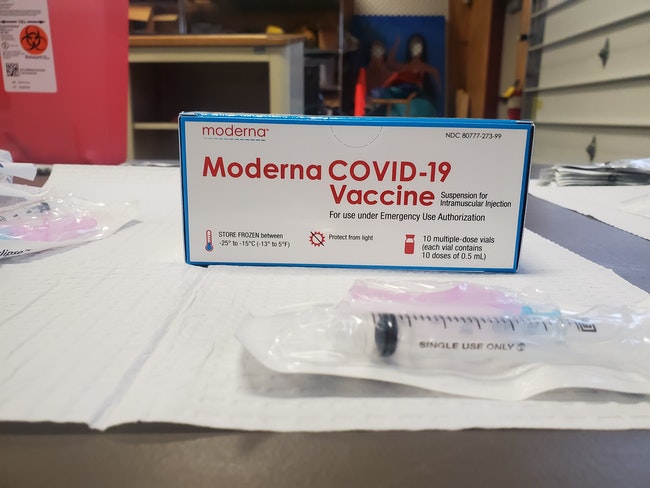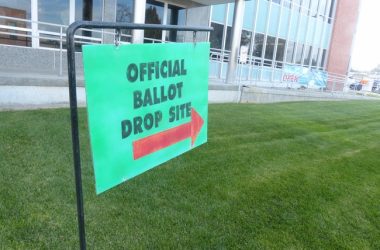
The Covid vaccine. (Liliana Frankel/The Enterprise)
ONTARIO – Local health care providers and public agencies are focusing on Malheur County’s Latino population as statewide data shows that Latinos are getting vaccinated at a fraction of the rate of their white counterparts.
In Oregon, only 6% of vaccine has gone to Latinos so far, despite the fact that Latinos make up 13% of the population and 25% of Covid cases. In comparison, 70% of vaccine has gone to Oregon’s white population, which makes up 75% of the general population of the state and only 50% of Covid cases.
Details about Malheur County aren’t available because the state has been withholding data about vaccine distribution by race and ethnicity because of the county’s small Black and Pacific Islander populations. If the data were released, it would be difficult to protect the privacy of those individuals, the state maintains.
Nonetheless, Sarah Poe, director of the Malheur County Health Department, said that “we know that we need to continue our work to reach those people who have been disproportionately affected to protect them with this vaccine. Our Latino community may be underrepresented in our vaccine distribution efforts at this time, and that’s why we’re so focused on improving access.”
State advocates strongly criticized the Oregon Health Authority’s approach at a recent press conference.
“The vaccination tier system that was launched in January of this year failed to apply a racial equity lens to ensure the Latino population and other comms of color would be prioritized for vaccination,” said Olivia Quiroz, executive director of the Oregon Latino Health Coalition.
She pointed out that while the state began vaccinating senior citizens earlier than the general population, the life expectancy for Latino farmworkers is only 49 years, so most did not qualify.
“It’s fair to say that the pandemic took us all by surprise, and we weren’t ready,” said Izzy Ventura Meda, executive director of Familias en Acción. “It’s really hard to know that this is where we’re at, still advocating and trying to get included into those vaccine rollouts and into those vaccine plans, knowing that the vaccine was coming for quite some time.”
As inequities have emerged in vaccine distribution, however, organizers and advocates have developed strategies to address them.
At a recent clinic at the Virginia Garcia Memorial Health Center, “what I saw were countless bilingual, bicultural folks, smiling, engaged, ready to offer information to people getting vaccinated,” said Serena Cruz, executive director of the Virginia Garcia Memorial Foundation. “(It’s about) creating spaces where people know the vaccine is meant for them, and that their lives are worth saving.”
The importance of partnering with local community members has not been lost on the Malheur County Health Department, which meets regularly with local nonprofits to discuss disseminating information and other ways to collaborate.
“We have attended numerous community meetings to share information, answer questions, and seek assistance in sharing our message that (since April 19) vaccines are available to all eligible members of our community, and that we work to accommodate as many people as we can,” said Erika Harmon, public information officer for the Malheur County Health Department. “We enjoy great support from (community-based organizations), and we value the relationship with have with them.”
One of those organizations is EUVALCREE, a nonprofit focused on developing the social capital and leadership capacity of Eastern Oregon’s rural and underserved communities. Norma Ramirez, EUVALCREE’s program director, said that the majority of the organization’s constituents had been receiving their vaccines through the county health department.
“Now that the health department has expanded their hours through late afternoon, we hope this will allow more farmworkers to have an opportunity to receive their vaccine without interrupting their work hours,” said Ramirez.
Farmworkers face compounded challenges in accessing the vaccine, including basic doubts about how to use health care in the U.S. Many farmworkers lack health insurance, and some may not have legal status, which restrains their engagement with government systems.
Rebecca Lemmons, Saint Alphonsus Health System’s regional director of community health and well-being, has been working since March to organize a mobile vaccine clinic that travels to communities. She recounted that at a recent clinic with farmworkers recently arrived to the U.S., she was asked to show vaccine serum to confirm that it wasn’t just water, as the workers reported they had seen in their home country in lieu of actual vaccines.
“We’re very talkative in order to share exactly what the process is, exactly where the vaccines come from,” said Lemmons. “People are coming from places that have had a wide variety of experiences with vaccines. We communicate with them so they feel informed about anything we’re doing with them.”
Outside the fields, the county health department has also offered employers the opportunity to vaccinate workers in local food processing plants and onion sheds. Many have accepted, but exact figures describing how many workers have been vaccinated or their ethnicity are not available.
EUVALCREE has been involved with a similar effort to bring the vaccine to Latino workplaces.
“You have to go to them,” said Roberto Gamboa, EUVALCREE’s director of operations and community development. “Because they work such long days, it’s just really difficult to plan an event that they’re going to attend.”
That’s why EUVALCREE is also looking to host vaccine clinics in other community places, like churches.
“We have had to approach faith leaders to be allowed to promote and host the events at their churches,” said Ramirez. “This has given us the opportunity to learn more of barriers and fears the community experiences related to the vaccine. Gathering this information proves useful when strategizing around vaccine efforts and how to encourage more people to receive the vaccine.”
Poe and Gamboa agreed that vaccine hesitancy was significant in the Latino community, just as in the general population.
“There’s this misconception that if you’ve had Covid, that you don’t need that vaccine,” said Poe. “But we know that people can get Covid twice. And we know that the immunity provided by the vaccine is greater than natural immunity.”
“Folks will believe more what they read on social media than from a doctor,” Gamboa said. “People need to hear the information from a trusted source. That’s why we have the Mexican consulate (invited to a recent vaccination event), because they’re trusted leaders within our community.”
Maria Vargas, regional outreach coordinator at the Oregon Health Authority, runs the agency’s Spanish-language Covid information Facebook page. She said she volunteered to do Spanish-language communications work for the agency at the beginning of the pandemic because she was thinking of people with limited English, like her mom, and what a scary time it was for them.
“There are still people holding out and waiting to see how other people do with the vaccine, and once they see that nothing is going to happen, that’s the thing that I’ve also seen in the Latino community,” she said. “Once someone has had a positive experience with something, they’re more likely to tell family and friends.”
While the efforts underway to vaccinate Malheur County are sure to reach many, there are still concerns over who’s being left out.
“I think it’s our homebound seniors, the ones that are residing in their home and don’t have any family members that could take them to a vaccination site,” said Glenda Gonzalez, supervisor and community health worker at Saint Alphonsus.
Ramirez agreed.
“We are appreciative and grateful of the current vaccine efforts being directed to communities who we know have been disproportionately affected by the COVID-19 pandemic,” Ramirez said. “However, our communities have expressed a need for more information directed to the senior citizen population.”
News tip? Contact reporter Liliana Frankel at [email protected] or 267-981-5577.
SAFEGUARD YOUR LOCAL NEWS
Take one action today to help the Enterprise grow and do more for the community through accurate, fair reporting.
SUBSCRIBE: A monthly digital subscription is $5 a month.
GIFT: Give someone you know a subscription.
ONE-TIME PAYMENT: Contribute, knowing your support goes towards more local journalism you can trust.




